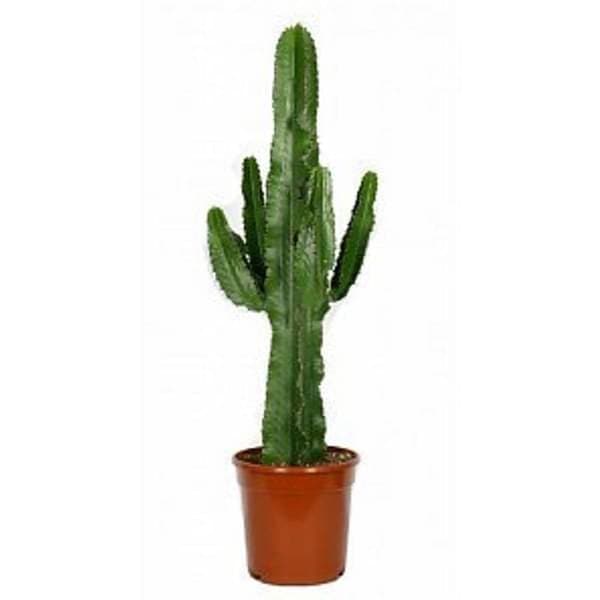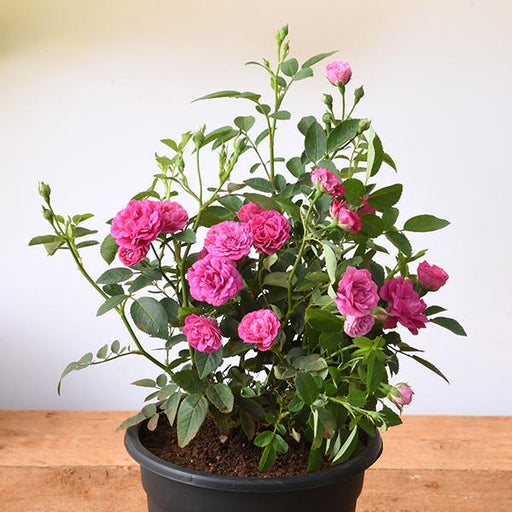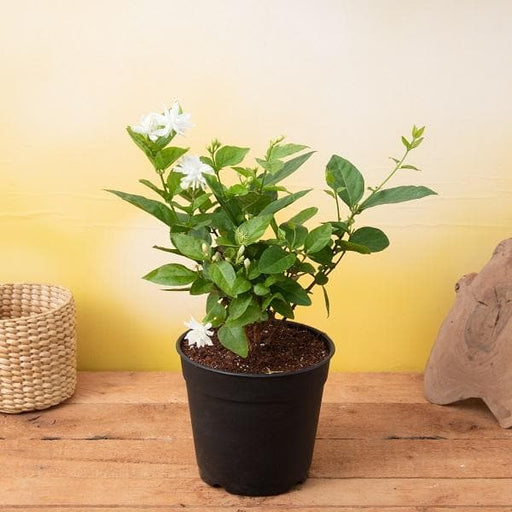
Cowboy, Euphorbia ingens - Succulent Plant
(MRP Inclusive of all taxes)
- Shipping ₹79 for entire order
- Dispatch in 7 days
- Country of origin: India

(MRP Inclusive of all taxes)
 Save 29%
Save 29%
Air Purifier Money Plant with Pot The Air Purifier Money Plant, also known as Pothos or Epipremnum aureum, is a stunning indoor plant that...
View full details
 Save up to 15%
Save up to 15%
Peace Lily, Spathiphyllum - Plant The Peace Lily, scientifically known as Spathiphyllum, is a stunning houseplant celebrated for its elegant white...
View full details
 Save 25%
Save 25%
Jasminum sambac, Mogra, Arabian Jasmine - Plant Jasminum sambac, commonly known as Mogra or Arabian Jasmine, is a fragrant flowering plant...
View full details
 Save 18%
Save 18%
Combo Constituents Includes the Parijat Tree (Night-Flowering Jasmine), a culturally significant plant with fragrant flowers. Description The Pari...
View full details
 Save 25%
Save 25%
Miniature Rose, Button Rose (Any Color) - Plant The Miniature Rose, also known as the Button Rose, is a charming and compact flowering plant that ...
View full details Save 25%
Save 25%
Damascus Rose, Scented Rose (Any Color) - Plant The Damascus Rose, also known as Rosa damascena, is a timeless symbol of beauty and romanc...
View full details
 Save 17%
Save 17%
Beautiful Fragrant Mogra, Arabian Jasmine Plant with Pot The Beautiful Fragrant Mogra, also known as Arabian Jasmine (Jasminum sambac), is...
View full details Save 15%
Save 15%
Pack of Vermicompost and Neem Cake for House Plants Transform your indoor garden with our premium Pack of Vermicompost and Neem Cake, spec...
View full details
Pack of Plant Growth and Flower Boosters Unlock the full potential of your garden with our Pack of Plant Growth and Flower Boosters! This ...
View full details Save 38%
Save 38%
Combo of Jeevamrut and Neem Raksha for Easy Growth and Protection of Houseplants Transform your indoor garden with our exclusive combo of ...
View full details Save 22%
Save 22%
Plant Nutrients Kit (Pack of 16) for a Healthy Garden Transform your garden into a lush paradise with our Plant Nutrients Kit, featuring 1...
View full details Save 16%
Save 16%
Combo of Top Plant Fertilizers Elevate your gardening game with our exclusive Combo of Top Plant Fertilizers, featuring two bags of premiu...
View full details Save 24%
Save 24%
Pack of 4 Additives to Make Soil Healthy and Nutrient Rich Transform your garden into a thriving ecosystem with our Pack of 4 Additives de...
View full details Save 30%
Save 30%
Transform your gardening experience with our premium Combo of Perlite and Vermiculite. This unique blend is designed to enhance soil aeration and ...
View full details Save 27%
Save 27%
Combo of 2 Vermicompost and Cocopeat - Enrich Your Soil Naturally! Transform your garden into a thriving ecosystem with our Combo of 2 Ver...
View full details
 Save 35%
Save 35%
Best 6 Plants for Perfect Indoor Garden Transform your living space into a lush oasis with our curated collection of the Best 6 Plants for a...
View full details
 Save up to 50%
Save up to 50%
Mini Succulent Garden Pack Transform your space with our Mini Succulent Garden Pack, featuring a delightful collection of 4 any variety beautiful s...
View full details
 Save 30%
Save 30%
5 Best Fragrant Plants Transform your garden or indoor space into a fragrant paradise with our curated selection of the 5 Best Fragrant Plants. Th...
View full details
 Save 24%
Save 24%
Set of 2 Bonsai Looking Grafted Adeniums Transform your indoor or outdoor space with our exquisite Set of 2 Bonsai Looking Grafted Adenium...
View full details Save 45%
Save 45%
Top 4 Die Hard Succulents Pack Transform your indoor or outdoor space with our Top 4 Die Hard Succulents Pack, featuring a curated selecti...
View full details
 Save 30%
Save 30%
5 Best Indoor Plants Pack Transform your living space into a lush oasis with our '5 Best Indoor Plants Pack.' This carefully curated collection fe...
View full details
 Save 25%
Save 25%
Set of 4 Evergreen Air Purifier Plant Pack Transform your indoor space into a lush, green oasis with our Set of 4 Evergreen Air Purifier Pla...
View full details| SrNo | Item Name | Qty |
|---|---|---|
| 2 | Cowboy, Euphorbia ingens Succulent Plant in 3 inch (8cm) Pot | 1 |
The Cowboy, scientifically known as Euphorbia ingens, is a striking succulent native to the arid regions of Southern Africa. This unique plant features tall, columnar stems that can reach heights of up to 30 feet, making it a stunning focal point in any garden or indoor space. Its vibrant green color and distinctive branching structure resemble a cactus, but it belongs to the Euphorbiaceae family, known for its diverse and resilient species.
What makes the Cowboy succulent special is its ability to thrive in harsh environments, showcasing its remarkable adaptability. This plant not only adds a touch of the wild west to your collection but also serves as a conversation starter due to its unique appearance and fascinating growth habits. Its milky sap, while toxic, has been historically used by indigenous cultures for various medicinal purposes, highlighting its significance beyond mere aesthetics.
One of the standout features of Euphorbia ingens is its impressive drought tolerance, making it an ideal choice for xeriscaping and low-water gardens. Its striking silhouette and minimal care requirements make it a favorite among succulent enthusiasts and gardeners alike.
The Cowboy Cactus, or Euphorbia ingens, is the rugged individualist of the succulent world. With its tall, spiky silhouette, it stands proud like a cowboy at high noon, ready to take on the desert sun. This succulent plant tree is not just a pretty face; it’s a low-maintenance marvel that thrives on neglect. Perfect for those who want a touch of the Wild West in their home without the hassle of constant watering. Just remember, this cactus doesn’t need a saddle, but it sure can ride the wave of drought!
Caring for your Euphorbia ingens is as easy as pie—if pie were made of sand and sunshine. This succulent tree thrives in well-draining soil and loves basking in bright light. Water it sparingly, and it’ll reward you with its striking presence. Think of it as the low-maintenance friend who always shows up to the party but never asks for a ride home. Just don’t overdo it; too much love can lead to root rot, and nobody wants that drama!
The Euphorbia ingens is the quintessential desert plant, embodying the spirit of arid landscapes. With its tall, columnar form, it’s like the skyscraper of the desert, reaching for the sky while keeping its roots firmly planted in the sandy soil. This plant is a master of survival, thriving in harsh conditions where most would wither away. It’s the ultimate testament to resilience, proving that even in the toughest environments, beauty can flourish. So, if you’re looking to add a touch of the desert to your home, this succulent is your go-to!
Welcome to the Euphorbia family, where the plants are as diverse as the personalities at a family reunion. Euphorbia ingens is just one of the many quirky members, known for its tall stature and unique appearance. This family is famous for its milky sap, which can be a bit of a drama queen—irritating if you’re not careful. But don’t let that scare you away; with proper handling, you’ll find that the Euphorbia family is full of charm and character, making it a delightful addition to your plant collection.
If you’re on the hunt for low-maintenance plants, look no further than Euphorbia ingens. This succulent tree is the epitome of “set it and forget it.” It doesn’t demand much—just a sunny spot and the occasional drink of water. It’s like that friend who’s always down for a good time but never needs to borrow your favorite shirt. Perfect for busy lifestyles, this plant allows you to enjoy the beauty of nature without the constant upkeep. Who knew being a plant parent could be this easy?
Bring the outdoors in with Euphorbia ingens, the indoor succulent that’s ready to steal the show. This plant not only adds a touch of greenery to your space but also serves as a conversation starter. Its unique shape and striking presence make it a focal point in any room. Plus, it’s a great air purifier, so you can breathe easy while enjoying its beauty. Just remember to give it a sunny spot, and it’ll thrive like a star in the spotlight, making your home feel like a desert oasis.
If you’re tired of watering your plants more than your pets, Euphorbia ingens is here to save the day. This drought-tolerant succulent tree is a champion of survival, thriving in conditions that would make other plants wilt in despair. It’s like the superhero of the plant world, requiring minimal water while still looking fabulous. Perfect for those who live in dry climates or simply want to reduce their watering chores, this plant is a low-maintenance dream come true. Say goodbye to guilt trips over forgetting to water!
Euphorbia ingens boasts some of the most unique succulent features you’ll ever encounter. Its tall, columnar shape resembles a cactus but is actually a member of the Euphorbia family. The spiky arms reach out like a cowboy ready to draw, making it a striking addition to any collection. Plus, its milky sap adds an element of intrigue—just be cautious, as it can be a bit of a diva. With its eye-catching appearance and quirky characteristics, this succulent is sure to be the talk of the town.
The benefits of Euphorbia ingens extend beyond its stunning looks. This succulent tree is a natural air purifier, helping to cleanse your indoor environment while adding a touch of the wild west. It’s also a low-maintenance option, perfect for those who want greenery without the fuss. Plus, its drought tolerance means you can enjoy its beauty without the constant worry of watering. It’s like having a pet that doesn’t need to be fed—just a little love and sunlight, and it’ll thrive!
If you’re looking for cactus alternatives, Euphorbia ingens is the perfect choice. With its tall, spiky appearance, it mimics the look of traditional cacti but offers a unique twist. Unlike its prickly counterparts, this succulent tree is less likely to poke you when you’re trying to admire its beauty. It’s the ideal plant for those who want the aesthetic of a cactus without the fear of getting jabbed. Plus, it’s just as drought-tolerant, making it a fabulous addition to your plant collection.
When it comes to succulent aesthetics, Euphorbia ingens is a showstopper. Its tall, striking form adds a dramatic flair to any space, making it a favorite among plant enthusiasts and interior designers alike. This succulent tree can elevate your decor from drab to fab in no time. Whether you place it in a sunny corner or use it as a centerpiece, its unique silhouette will draw the eye and spark conversation. Who knew a plant could be such a style icon?
The Cowboy, or Euphorbia ingens, is a succulent superstar! This cactus-like plant boasts tall, green stems that resemble a cowboy's lasso. Native to Africa, it thrives in arid conditions, making it the perfect low-maintenance companion for those who prefer a hands-off approach to gardening. Just don’t expect it to wear a hat!
Caring for your Cowboy is as easy as pie—if pie were a drought-resistant plant! Place it in bright, indirect sunlight and water sparingly. Let the soil dry out completely between waterings. Remember, this plant prefers to be thirsty rather than soggy. Overwatering is the only thing that’ll make it throw a cactus-sized tantrum!
Absolutely! The Cowboy is a fantastic indoor plant, bringing a touch of the wild west to your living room. Just ensure it gets plenty of bright light and a well-draining pot. It’s like having a little piece of the desert right in your home—minus the tumbleweeds and rattlesnakes, of course!
Yes, the Cowboy is a bit of a drama queen when it comes to pets. Its milky sap can be toxic if ingested, causing irritation and discomfort. So, if you have furry friends, keep this succulent out of their reach. It’s best to let your Cowboy be the only wild thing in your home!
Water your Cowboy sparingly—think of it as a cactus on a diet! During the growing season, every 2-3 weeks should do the trick. In winter, cut back to once a month. Always check the soil first; if it’s still damp, let it be. Remember, a thirsty Cowboy is a happy Cowboy!
Your Cowboy craves well-draining soil, like a cowboy craves a good rodeo! A cactus or succulent mix works wonders, allowing excess water to escape while keeping the roots happy. You can even add perlite or sand for extra drainage. Just don’t let it sit in soggy soil—no one likes a mud pit!
You bet! Propagating your Cowboy is as easy as pie—again, if pie were a plant. Simply take a cutting, let it callous over for a few days, and then plant it in well-draining soil. Water sparingly until it establishes roots. Soon, you’ll have a whole herd of Cowboys to show off!
While the Cowboy is tough, it’s not invincible! Watch out for mealybugs and spider mites, the pesky outlaws of the plant world. If you spot them, a gentle wipe with soapy water or neem oil will send them packing. Keep your Cowboy clean, and it’ll stay happy and healthy!
Your Cowboy can grow quite tall, reaching heights of up to 10 feet in the wild! However, in a pot, it may stay a bit more modest—around 3-5 feet. Just remember, the bigger the Cowboy, the more impressive the show! It’s like having a mini desert landscape right at home.
Yes, indeed! While it’s not a show-off like some flowering plants, the Cowboy can produce small, yellow-green flowers. These blooms usually appear in the summer, adding a touch of charm to its rugged appearance. Just don’t expect a floral extravaganza; this plant prefers to keep things low-key and laid-back.
Your Cowboy loves warm weather, thriving in temperatures between 65°F and 80°F. It can tolerate a bit of chill, but anything below 50°F is a no-go. Think of it as a sun-loving cowboy who prefers to avoid the cold nights of the desert. Keep it cozy, and it’ll be your loyal companion!